Please Upload a Tsr and Esxi Logs
A VMware ESXi instance volition generate a ton of events throughout its lifetime. These events, depending on blazon, volition be written to ane or more than log files, the bulk of which are constitute under /var/log in the ESXi filesystem. As with any log file, the idea here is to help you and others troubleshoot issues and continue an eye on things by perhaps forwarding important events to a syslog server and such. Log files too make for an excellent audit trail and then you tin can determine, for case, who or what is accessing your hosts, VMs, etc.
As per VMware's documentation, I've listed eight of the nigh often used log files on ESXi.

Some of the log files present on an ESXi host
Annotation: If you are experiencing bug with ESXi y'all may consider patching to ensure you take the latest bugs stock-still.
VM Log Files
In addition to the above, every Virtual Car hosted on ESXi will have corresponding VM log files called vmware.log recording events related to automobile activeness, system failures, hardware changes, migrations, condition so on. To view the log file, SSH to the ESXi host and navigate to the datastore on which the VM folder resides.
The path to the log file should be similar to /vmfs/volumes/<datastore>/<virtual machine>/vwmare.log as shown in the side by side screenshot.

Displaying the contents of a VM's log file on ESXi
In that location are some adjustments you lot tin make to the log rotation and logging options for a VM. I've summarized these as follows:
- Disable or enable logging : Prepare the logging value in the VM'due south VMX file to false or true respectively. You lot can practice this by editing the VM'due south settings (VM Options -> Advanced -> Edit Configuration) in vSphere Spider web client as shown.
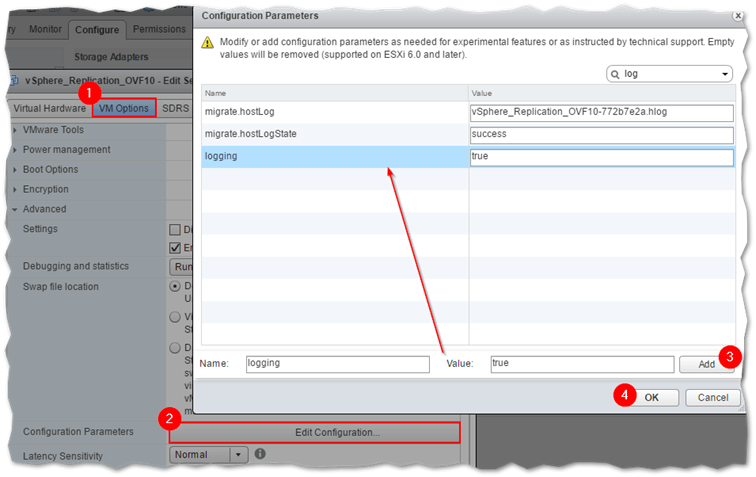
Modifying the log file options for a VM
Alternatively, logging tin can exist enabled or disabled via the Enable Logging option. It is too possible to include diagnostic information via the Debugging and statistics drop down box.
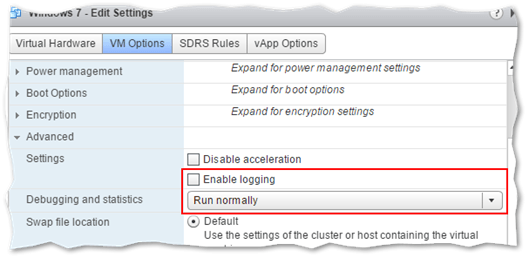
Enabling logging for a VM in vSphere Spider web client
- Logfile size : Similarly, you lot can control the log file size by adding the log.rotateSize to VM's VMX file. Ex: log.rotateSize=1024000 sets the log file maximum size to one MB.
- Logfile retention : To ready the level of log file rotation, add the log.keepOld value to the VM's VMX file. Ex: log.keepOld=5 sets a maximum of five log files at any one example, with the oldest being overwritten when a new log file is created. You'll discover these listed as vmware.log , vmware-i.log … vmware-n.log .
- Logfile name : To change the log file filename and/or location, add the log.fileName to the VM's VMX file. Ex: log.fileName=vmLog.txt or log.fileName=/vmfs/book/VMLogFiles/vm1Log.txt.
Note: The higher up should work for most pre-ESXi 6.5 versions as per this KB. I've besides tested this on ESXi half dozen.5 and the only parameter that seems to be unsupported is log.fileName in that the vmware.log filename is retained regardless of the value set.
Viewing ESXi log file contents
From Crush
An easy way to view logfiles on VMware ESXi is to SSH to the host and utilise old fashioned Linux commands such as true cat, more, less, tail and head with a little bit of grep thrown in for filtering. Here are a couple of examples.
In this starting time ane, I'g displaying the final 15 lines from the vmkwarning.log using the command tail -n xv <filename>. This is marked (1) in the next screen screenshot. The text labeled (ii), tells united states that the host is failing to connect to host 192.168.xx.20. As it turns out, 192.168.20.xx happens to be the IP accost of a replication server I had set on a second vCenter case, which was powered off at the time.

Tailing and inspecting the content of a VMware ESXi log file
Hither's another example, where I employ the auth.log log file to determine if connections are being established from subnet 192.168.11.0 and by whom. To do this, true catauth.log and pipe it into grep filtering by the string 192.168.11 as shown. The output shows a number of successfully established SSH connections via the root account from the 192.168.xi.45.

Using the auth.log file on ESXi to determine who accessed the host
Using the ESXi host customer
The ESXi host customer makes it even easier to view the contents of a select number of log files. Navigate to Monitor -> Logs to view the listing of logfiles bachelor for viewing. Highlighting a log file, displays the contents in the underlying pane which can be copied to the clipboard and exported to file.
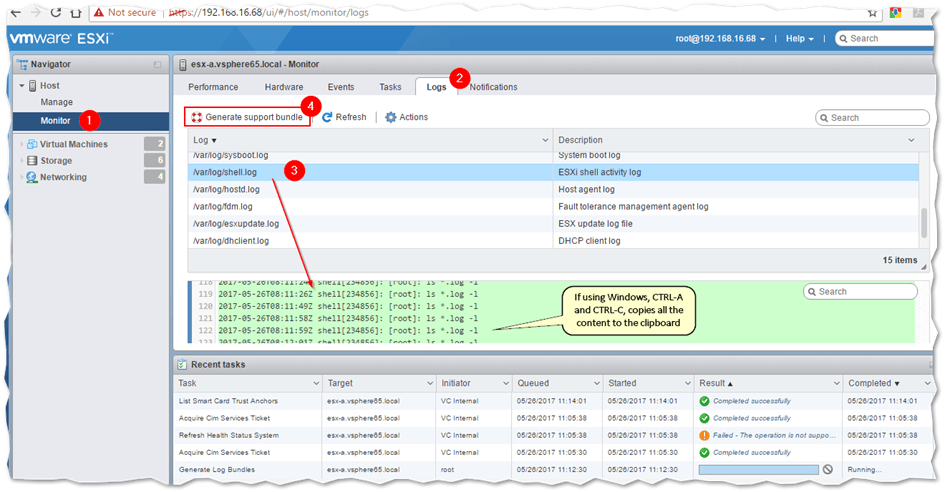
Viewing ESXi log files using the ESXi host client
You tin can also generate a log bundle (encounter side by side department) using the Generate support bundle button labeled (4) in the above screenshot. When the task finishes, yous are prompted to download the package to a binder on your computer.
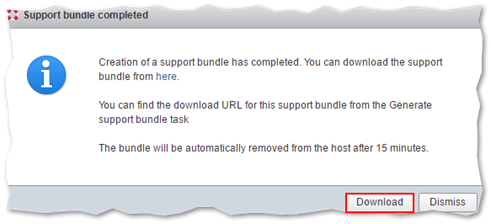
Downloading a generated package file using the ESXi host customer
Generating an ESXi Log Packet
There may be times where yous just cannot solve an issue. Calling VMware support is one mode to go well-nigh information technology and if you practice, generating a log or host support file package is one affair you'll be asked to exercise. This is then uploaded to VMware for further troubleshooting and diagnostics.
Nosotros've already seen how the bundle is generated via the ESXi host client. There are a couple more than methods you tin can use.
The showtime is to run /usr/bin/vm-back up from within an SSH session while logged equally root. Once the package file is generated, you lot can copy information technology using scp or similar.
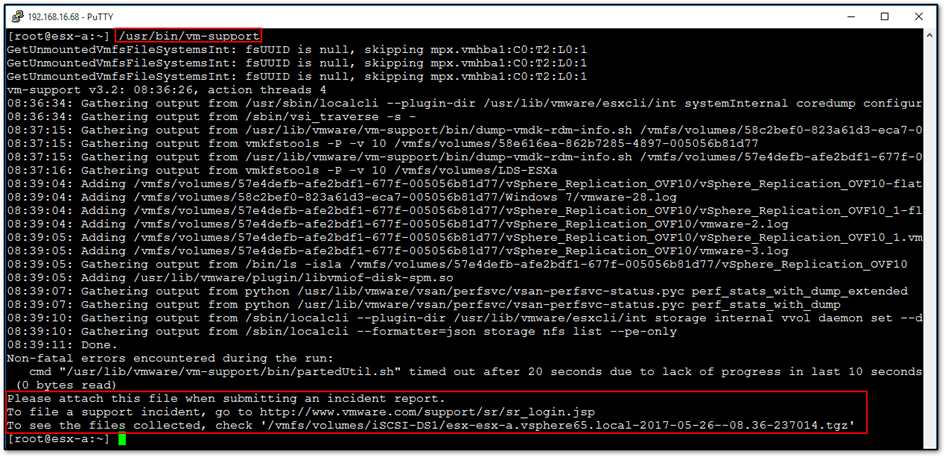
Generating an ESXi log package via script
The second method is easier. But point a browser to http://<ESXi IP accost/cgi-bin/vm-support.cgi. You are promoted for the host'south credentials later on which, thevm-back up script is executed on ESXi. The generated bundle is so downloaded every bit a compressed tar file (TGZ). The procedure may take a while depending on the size of the logs, host utilization, uptime, etc.

Generating and downloading an ESXi log parcel via a CGI script
You can then upload the bundle to VMware's site using the vSphere Web client. Just navigate to Administration -> Support -> Upload File to Service Request and click on the Upload File to Service Asking button. Finish off by selecting the bundle file with the Choose File push button and press OK.
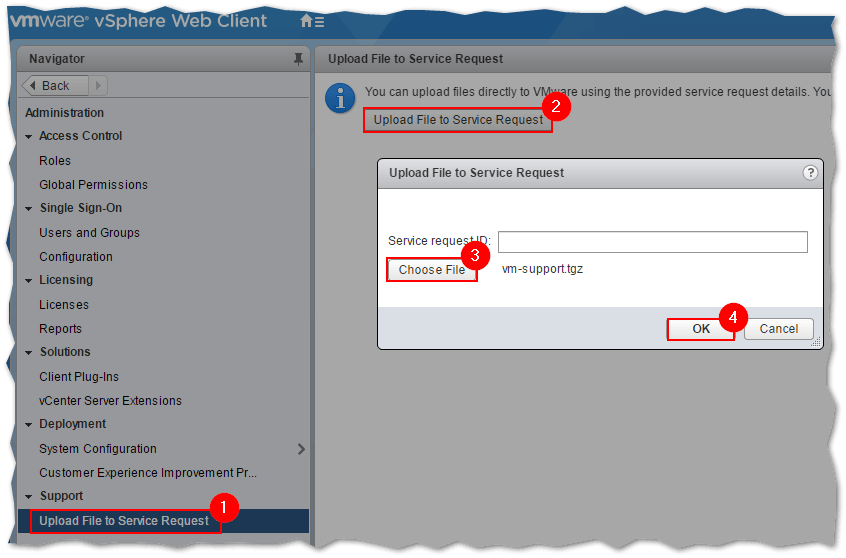
This post should have given y'all a bones introduction to some of the log files generated by VMware ESXi and VMs and how they are used to troubleshoot and diagnose bug. We've likewise had a look at ways by which a support parcel is generated whenever VMware support is called for.
For further details, accept a await at the System Log Files department on the vSphere 6.v documentation website.
[the_ad id="4738″][the_ad id="4796″]
parkeronewarthill46.blogspot.com
Source: https://www.altaro.com/vmware/introduction-esxi-vm-log-files/
0 Response to "Please Upload a Tsr and Esxi Logs"
ارسال یک نظر